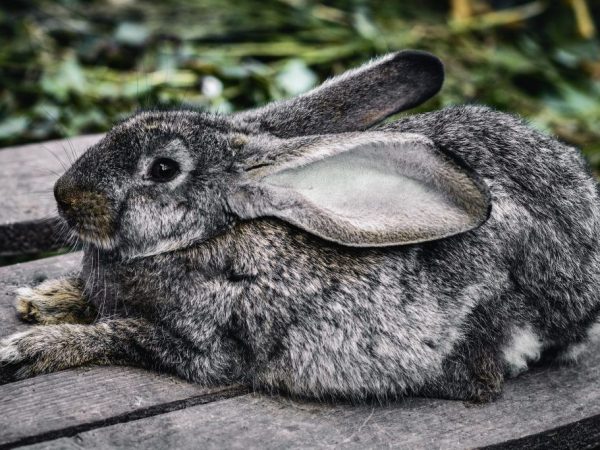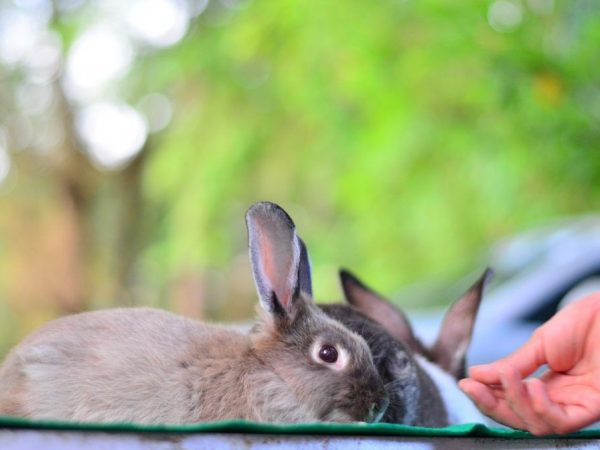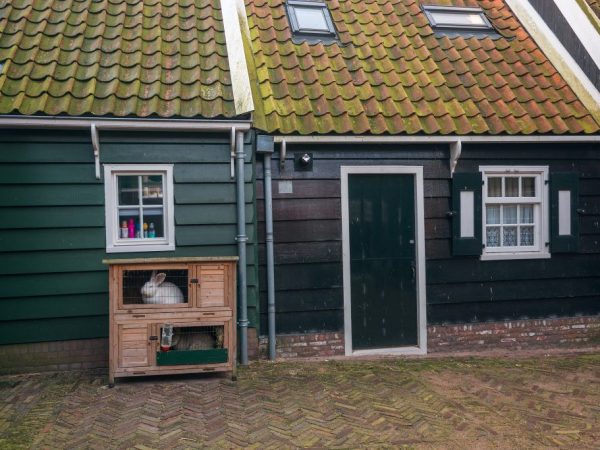Why does the rabbit tear fluff, but does not make a nest
Okrol is always an expected event on the farm. In order for the birth of rabbits to be successful, a number of preparatory steps should be taken. A queen cell is installed in the cage, a rabbit's nest, which the female insulates with her own wool.

The rabbit tears fluff, but does not make a nest
The nest must be ready for nesting, otherwise the babies may freeze. However, pet owners often face the problem that the rabbit nest is not ready for childbirth. What to do when the female refuses to warm the mother plant?
The reasons for the lack of desire to build a nest
The female rabbit begins preparing the nest about three or five days before giving birth and has time to make it. Her behavior during this period changes, the rabbit rakes up the straw in one corner, after which she fights the fluff in her, which she covers the dry grass.
The construction of a future dwelling for rabbits does not take much of the animal's time: a female rabbit is able to build a nest in a couple of hours. Most often, how much she will build a rabbitry depends on the number of future cubs. An important material for creating a mother liquor is high quality hay. It is necessary to try not to use motley hay as a bedding: such a rabbit estate can provoke the appearance of allergies in small eared ears. Before use, the material must be checked: there must be no debris, mold or parasites in it.
The brood can be placed in the cage as soon as the rabbit starts raking hay in one corner. This usually serves as a signal for an approaching okrol. From this moment on, the condition of the animal should be checked every day in order to provide timely assistance with the birth of the rabbit.
Why does the female not build a nestPregnancy in rabbits lasts a little over a month. If 27-28 days have already passed after the hunt, and the female has not tore the fluff from herself, then something does not suit the animal in its own cage or it has health problems.
Rabbit breeders argue that such behavior of expectant eared mothers is not uncommon. The main reasons why a rabbit does not make a nest are:
- stressful environment;
- unbalanced diet;
- lack of mother liquor or poor quality materials.
The life of the cubs will largely depend on the efficiency of actions. If you do not equip a nest for a rabbit in time, she may abandon offspring.
It also happens that the mother cell is installed, the rabbit woman began to warm it and then, for unknown reasons, left the prepared nest without completing it. In this case, you need to check: perhaps the workpiece is damaged and the expectant mother feels uncomfortable in it.
Stress during rabbit pregnancy
Okrol is always a high level of stress on the body of the newly-born rabbit mother. If the environment in the house makes the animal constantly nervous, the likelihood of a miscarriage increases. Also, the animal will not build a nest in a place it considers unsafe.
If the rabbit tears up the fluff from herself and puts it in hay, you should try to minimize the noise level around the animal to the limit. Also, there should be no chemistry with an aggressive smell near the cell. Cleaning of the pet's home is carried out without sudden movements, but you should not neglect the sanitary standards.
Sometimes, due to the stressful environment, the rabbit pulls the fluff out too early. Such nesting material should be removed from the cage, since in 5-6 days it can dump and become a habitat for various insects.
When inspecting, the rabbit must be handled with clean hands. It is forbidden to use perfume or soap with a pronounced smell, it is better to rub your hands with wormwood. Do not allow other pets to approach the pregnant rabbit.
If the animal has the first nest, then the reluctance to build a nest may be associated with the loss of the maternal instinct. Breeds of breeds of rabbits are especially susceptible to this. It is necessary to carefully monitor the actions of such a rabbit after the birth: if she incorrectly divided the rabbits, shows aggression or throws them around the cage, the cubs should be placed on another nurse.
Diet of a pregnant rabbit
A balanced diet is the key to the health of the offspring and the mother. Exhaustion can lead the female to understand that she will not be able to give birth and provide the first days of the rabbits. In such a situation, the rabbits do not build a nest and abandon the cubs.
The consequences of such a refusal are often the death of newborns: without a nest, babies freeze and die, thereby freeing the rabbit from an unbearable burden.
Of course, the farmer is not happy with this situation, and therefore, if it is noticed that the rabbit is behaving incorrectly, you need to prepare for the fact that the newborns will have to be resettled to another fluffy mother.
The feeding of the rabbit is made on the basis of three parameters:
- volume of food;
- regularity of feeding;
- calorie content of feed and saturation with nutrients.
The diet of a pregnant rabbit should contain a full range of vitamins and minerals. With a lack of calcium and phosphorus in newborn rabbits, bones can be deformed. If there is no iron or magnesium in the menu, the nervous and circulatory systems will suffer.

Diet of a pregnant rabbit
Also, the quality of the feed affects the level of difficulty of childbirth. Vegetables should be fresh and juicy, and cereals should be crushed.
A feline female should eat 1.5 times the daily amount of food per day. If you give the animal less food, then the risk of fetal freezing and miscarriage increases. However, do not overfeed the female. Obesity has a detrimental effect on the okrol process because the uterus is unable to contract properly.
The diet should be strict. It is important to try to feed the bunnies at the same time. Irregular eating also causes stress in the pet. This usually results in disorders of the digestive system. Also, the female, unsure of the stability of the diet, may abandon the offspring, since she considers it burdensome in such a situation.
If the animal's diet is balanced, then it will calmly start building a nest. Do not use hay from tops or grasses as nesting material, otherwise rabbits will eat it up.
How to make a queen cell with your own hands
To equip a place for a future rabbit's nest with your own hands, you need to fulfill several conditions. First, the cage must be large enough to accommodate the queen cell. Some designs of rabbit dwellings involve a nest. In most cases, however, the animal's cage may be too small to enclose.
For the mother liquor, you can use a special closed box with one round entrance. The size of the box should ensure that the bunny and the cubs can fit without any problems. A small mother can lead to accidents: the female is able to accidentally crush the cubs if she does not have a place to turn around.
The entrance to the box should be located high so that the rabbits do not get out of it in the first few days. Sometimes a regular open-top box can be used as a queen cell, but the walls must be high enough so that the cubs do not fall out.
You can make a mother plant with your own hands, for this they use good wood. Oak, maple or birch will do. It is undesirable to use the wood of fruit trees for these purposes: rabbits may develop allergies.

Rabbit brood
Little rabbits are born completely helpless and naked. In the first few days, their life depends on how well the mother liquor was insulated. It is necessary to ensure that the fluff that the female tore for the nest is fresh and not matted. For the rest, there is no need to interfere with the animal: careless actions can scare him away.
The mother should be kept in a dry, warm place without drafts. The rabbit is demanding about the choice of a place for a future nest and will not tolerate bad conditions. It is necessary to make sure that the female likes the place of the box: when the rabbit tears the fluff for the nest, she often does not know the measure, and if she does not like the building, she can destroy everything and start over. This also affects the rabbit herself: the animal can be so carried away by restructuring that wide bald spots will appear all over the body.
Additional nuances when building a nest
In some cases, the female tears the down so hard that she can accidentally injure herself with sharp teeth. Such wounds are treated with a 3% hydrogen peroxide solution. If this happens, the animal may stop making the nest and feel uncomfortable for a while. However, usually before the birth of the rabbit, they still finish building a shelter for the cubs.
If the female was still unable to make a nest, an artificial one must be recreated. The hay is kneaded with hands wearing wet disposable gloves. After this mass is mixed with the down of the animal and placed in the mother liquor. There is no guarantee that the rabbit will like such a replacement, but still the chance of a successful birth increases. If the female refused to give birth in an artificial rabbitry, then you should be ready. Immediately after the babies are spawned, most likely you need to put another rabbit, otherwise they will die.
Summarizing
So, the organization of the nest is an important moment for the future breeding. There can be many reasons why a female refuses to build a rabbitry. Most often this is due to the loss of maternal instinct, but stress or poorly formulated diet can also affect.
The uterus needs to be made with your own hands, but the female must bring it to mind. If this does not happen, then you can artificially insulate the nest, but in this case, the rabbit will most likely abandon the offspring. To prevent this from happening, it is necessary to comply with the sanitary standards for keeping the pet, protect the pregnant rabbit from sources of noise or a pungent odor. Also, therapeutic prevention does not hurt: diseases can also act as a source of stress for the animal.


